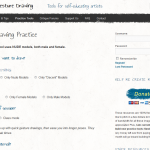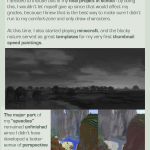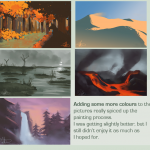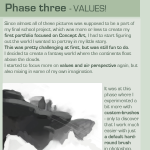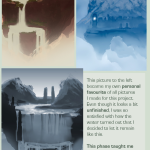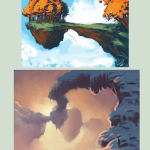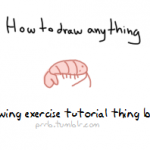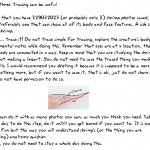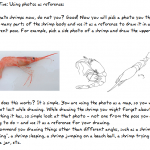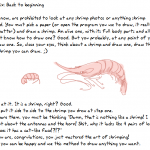Tag: practice
Untitled
Do it wrong.
Cartoonists, writers, musicians, actors, filmmakers, we all get the same questions. And we all have boring, stock answers like ‘draw every day’ or ‘practice a lot’. Sometimes it’s because we don’t know what we did right. But the real reason is that every bit of advice we give you has an expiration date. The world of art is always changing. The things people like, the way those things are distributed and sold is always changing. By the time you put in all that practice to get good at what someone else told you is the way things are done, they aren’t done that way any more. The only sure way to become great at what you do is to break the rules. Not for the sake of being a rebel, but so that you can make something only you can make, in a way only you can make it. If you do something wrong well enough, it becomes the new right. So here are 5 steps in the right way to do it wrong.
STEP 1: Practice
To become a good artist:
Focus on making perfect art. Don’t show weakness. Use the tools that everyone else recommends. If you can’t draw hands, put them in pockets. If you can’t draw feet, crop them off the page. If you’re not very good at an instrument, play something easier. If you’re not knowledgable in a subject, write about something else.
To become a great artist:
Just make a bunch of crappy art. Do things wrong. Trust me, even the art you think is great, give it a few years and you’ll think it’s crap. So you might as well shoot for the moon. Grab tools that no one else has ever even imagined using, and see what happens. Draw everyone on horses even though you know the legs are going to come out all weird. Perform that long, flowery monologue you know you’re going to forget the words to. Film that science fiction epic even though the only creature effects you can afford are sticking Halloween stuff on your cat. Doing things you know you can’t do well so that you can do them later is the whole idea behind exercise.
STEP 2: Taking criticism
To become a good artist:
Show your only your best work to people you trust. Enjoy the praise, and ignore the haters.
To become a great artist:
Share your work with everyone, even the jerks. Put it online, show it to strangers. Show them the stuff you’re proud of, and the stuff you’re not sure of. When you show just your average art, people have nothing to say, so they just give you empty praise. But show them something that can be improved, and they’ll tell you about it. The stuff they tell you is gold. Don’t just be disappointed, write that crap on a post-it and put it above your desk. Think about it when you work. Each and every one of them gave you a free mini art lesson. If they were dicks about it, that makes them a bad teacher, it doesn’t make you a bad artist. There’s a very good chance that they are wrong. But thinking about what they said, and why you disagree with it, helps turn that problem into a technique. Sifting through critiques is like panning for gold. Sift through the muck of poor wording and trolls to your own little takeaways. Write it on a post-it note and put it above your desk. Think about it while you draw. Use it.
STEP 3: Improving
To become a good artist:
Did you try something new and get a bad reaction? Oh no! Listen to the advice people give you and take that element out of your work. Make something people like.
To become a great artist:
Did you try something new and got a bad reaction? Awesome. There are two reasons that people say negative things about your art: because they see something worth improving, or because you’ve somehow struck a chord. Either way, you made them feel something. Figure out how you did it, and how best to use that skill. Did something you did make someone angry? If you offended or hurt someone, you now know how to avoid doing that in the future. But if you made someone feel something about the story or characters, you now have a skill that you can hone and use as a tool at a better point in the story. To make people angry, sad, happy, uncomfortable, or in any way emotional when looking at your work is a skill that few have because we’re so used to beating it out of our work. Many people compensate for this by adding shock value. You can learn to do it with emotion.
STEP 4: Dealing with rejection
To become a good artist:
Find out where art like yours is being published. Submit to them! Rejected? That’s too bad! Try again! Send them your new stuff every year! Never give up! One of these years, it will all work out!
To become a great artist:
Getting rejected is great! When you get a rejection letter, you aren’t losing a job, you’re gaining one. Finding a venue and an audience is now up to you, which is great, because if you’re successful, you’ll be the one getting rich from your work. All of those places were created because someone needed a new place to put a different kind of work. You’re now in the same boat.
STEP 5: Building a career
To become a good artist:
After a lot of practice and study, take all the advice people have given you, follow their lead. Make something you know will be successful, put it in all the right venues.
To become a great artist:
Do it wrong. Don’t do it right just because of all the people around you who say ‘that’s not art,’ ‘that’s not music, ‘there’s no money in that,’ ‘it’s not a real book unless it’s in print,’ etc. Some of those people will be your heroes. Every generation hates the next generation’s music. Every generation of artists thinks the next generation are hacks. Following the leader is a good way to make art that pleases people in the moment, but doing something that breaks all of the rules is the way be the leader and make something historic. Tell a story only you can tell in a way only you can tell it. When you see a piece of new technology, a piece of ancient technology, an interesting bit of trash on the street and think ‘I could put art on that’, then put art on that. You’ll be reaching new people in places no one else is even trying. There’s no money in ANYTHING until someone puts something great on it. When someone tells you you’re doing it wrong, that’s your clue that you’re doing something that could change all of the rules, and a few decades from now, your style will be the one someone’s drilling into a beginner’s head, and that beginner will be coming to you for advice. Feel free to tell them what you did right, but be sure to also tell them: Do it wrong.
Untitled
Source: FOERVRAENGD
List of tutorials that helped me with environmental painting:
“How to make your own Perspective Grid in PS” <—- this one is the best thing I’ve ever discovered. Srsly CHECK IT OOOOUUUUT!
Snuffen’s Background Tutorial P1More or less ALL tutorials by Griffsnuff is awesome, so make sure to check out the rest of them!
More or less ALL tutorials made by AquaSixio!List of youtube channels that also helped and inspired me:
FZDSCHOOL – More or less one of the most known concept art-related resources I know on youtube. It’s great to sit and draw and just listen to the talking.
SinixDesign– This guy is also great! He has some design workshops ever now and then where the viewers can send in their stuff for critique! very encouraging and inspiring!
moatddtutorials– This guy is more into drawing than painting, and has a more cartoony style. He has interesting methods when it comes to perspective. And he also challenge himself in some of his videos (the engine block video is a great example of this)
foxOrian– Also known here on dA for his awesome perspective and composition tutorials. He has a youtube channel where he posts some videos that might be interesting as well.
